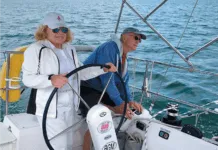In his book, Nigel Calders Cruising Handbook, Calder takes a detailed look at both the necessary and desirable features of deck hardware. Heres some of his advice:
All cleats on the mast (and many elsewhere) need to be large enough to take not only the two turns needed to cleat off a line, but also (at least on the top end of the cleat) to then comfortably hold another turn that is used to stow the line (as a general rule, the length of a cleat should be at least sixteen times the diameter of the line to be stowed on it). Too often, the horns are barely long enough; in rough weather, the stowed line comes loose and streams back down a side deck or overboard.
For more information and advice on what to look for in and on a boat for your cruising, purchase Nigel Calders Cruising Handbook from Practical Sailor.




































